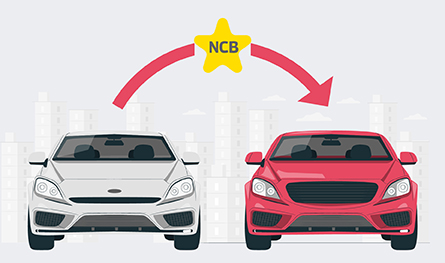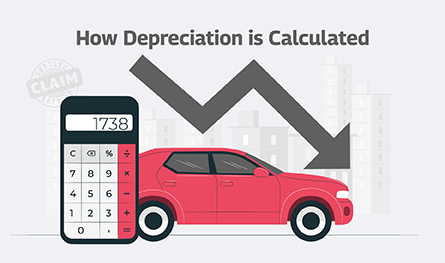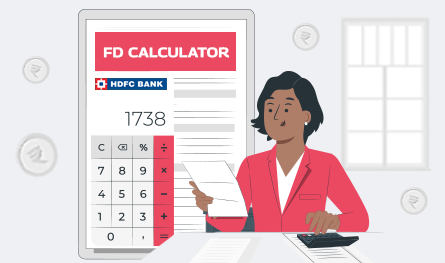Did You Know that No-Claim Bonus Can be Transferred from One Car to Another?

NCB or No Claim Bonus is offered to car insurance policy holders for every claim-free year. In case a policyholder doesn’t raise a car insurance claim for a year, the insurance company offers them an NCB bonus of 10 to 20 % depending on the policy chosen. However, this bonus can be transferred from one car to another in case the policyholder buys a new car.

What is NCB or No Claim Bonus?
While costs, in general, tend to climb, car insurance provides a distinctive opportunity in that premiums can potentially decrease year after year owing to the NCB.
Smart policyholders are aware of this no-claims discount and understand its importance in netting savings in future years when they renew their car insurance policy. However, there are several features of NCB in car insurance that new policyholders may be unfamiliar with, one of which is the No Claim Bonus transfer from one car to another. This blog will be a guide on this process.
NCB Transfer Rules
According to the IRDA rules for NCB transfer, the No-Claim Bonus belongs to the individual policyholder, not the car. This implies that when a car is passed on to another individual, just the insurance coverage may be transferred. The No Claim Bonus in the current policy stays with the original policyholder.
Also Read: 9 Seater Car
How to transfer NCB from one car to another?
Generally, you may transfer your existing NCB to another vehicle. However, if you change insurance provider before the end of the year, you will not be eligible for the No-Claim Bonus for that particular year.
If you are looking to transfer your NCB to another person without changing providers, you can contact your insurance company or agent and ask for the details of the process. Some companies may include your confirmation of no raised claims in the car insurance renewal statement for your motor insurance. You can provide the same during the transfer as proof of zero-raised claims. The only requirement is that you need to be the policyholder of both the insured car at the point of NCB transfer.
Also Read: Difference Between Hatchback and Sedan
How to transfer NCB with a New Insurance Provider?
If you have been using the same insurance company for a long time, you can still buy from a new provider and get NCB. However, verification from your insurer will be required.
Here is a step-by-step breakdown of the procedure:
- Visit your previous insurance company.
- Initiate a No-Claim Bonus transfer and provide all relevant documentation.
- The No-Claim Bonus certificate will be issued by your former insurance provider.
- Send the No-Claim Bonus certificate to your new provider.
- The No-Claim Bonus will be transferred to your new insurance provider.
Required Documents include:
- Application for Transfer
- Car insurance Photocopies
- Buyer-Seller Contract i.e Form 29 and Form 30
- Photocopies of the previous registration certificate or the ownership transfer certificate
- Delivery Note Photocopies
- Booking receipt Photocopies
- NCB Certificate
To relocate the NCB from the current insuring firm, the primary car owner must file Forms 29 and 30 – together with a statement explaining the application. The motor insurance company would be required to provide an NCB certificate that is effective for three years. This document must be shown to the new insurance firm that will be covering your car. When purchasing auto insurance digitally, the certificate is not necessary; instead, a statement from the policyholder is sufficient.
Under no circumstances should the policyholder conceal any information, such as raised claims- the new insurance provider will undoubtedly verify the information provided by the prior insurance company.
Also Read: Cheapest Car in India
NCB transfer of Company Vehicle
The No-Claim Bonus on a corporate automobile is only transferrable to another vehicle if the employee is specified as the policyholder on the employer’s insurance plan. The benefit of business auto insurance coverage is that if NCB accumulates, the insurer merely requires verification from the company to transfer the No-Claim Bonus.
Also Read: How to Check NCB in Bike Insurance
Please Note
Even if you possess absolutely no bad intentions and put any amount for NCB when transferring insurance coverage, the repercussions might be severe. If you declare your NCB incorrectly, your insurance company may dismiss your auto insurance claim entirely. That implies that if you state the incorrect NCB while applying for insurance, you’ll get the same coverage as if you didn’t apply at all.
Whether you are transferring auto insurance policies, make sure you mention if you have filed any claim with your former insurer in the preceding year. Insurance firms can readily obtain this information, and although you may receive the coverage, there will be a difficulty when it comes time to file claims; therefore there is no purpose in concealing or providing wrong data.
Also Read: Difference Between Comprehensive and Third Party Insurance
Can NCB of Previous Car Insurance be Used to Lower the Premium of New Car Insurance?
NCB is a reward that insurance companies provide to the policyholder if there have been no claims raised during the previous year. To calculate NCB, insurers use the car insurance policy of the insured as a reference. Hence, policyholders can avail the benefits of NCB even if they change their insurer and insurance policy.
There are some ways to use the NCB of your previous vehicle to limit the premium on your new vehicle. Below are some points on how you can effectively use your NCB on an old car to lower the premium on your new car:
- Earn NCB – The first step in this direction is to earn NCB on your car. This can be done by maintaining precaution while driving, following rules, and limiting the chances of raising claims. If you can avoid any heavy financial burden in terms of car damage, you can manage the minor claims on your own to keep your NCB undamaged.
- Retain NCB – You are aware that your NCB increases with every no-claim year for 5 consecutive years. Most insurance companies allow a maximum discount of up to 50% on your car insurance policy. So, if you have an NCB of 50% earned after 5 consecutive no-claim years, you can avail of a 50% discount from the 6th year onwards. This accumulated NCB discount can be utilized while buying a new car to get a 50 % discount on premiums. You will have to transfer the NCB from the old car insurance to the new car.
- NCB Certificate – The NCB certificate is a requirement that you would need to enjoy the benefits of your NCB discount and retain it while changing your old car insurance to acquire a new one. Thus, if you are buying a new insurance policy for your new car from the current insurer, you should request a copy of the NCB certificate. Similarly, if you are buying a new policy from a different insurer, you should request the old insurer for an NCB transfer letter and certificate so that you can enjoy the NCB discount on your new car policy.
What is the Procedure to Calculate NCB?
Your NCB discounts keep increasing with each claim-free year for 5 consecutive years. It is capped at 50% after 5 years. The table below shows how NCB increases each year and how it is calculated:
| NCB Status | Discount |
| One claim-free policy year | 20% |
| Two consecutive claim-free policy years | 25% |
| Three consecutive claim-free policy years | 35% |
| Four consecutive claim-free policy years | 45% |
| Five consecutive claim-free policy years | 50% |
| 6th year onwards, NCB remains | 50% |
What is NCB Protect Add-on and How is it Used?
NCB is an important discount on car insurance that everyone likes to retain. Although you strive hard to retain the NCB earned, you cannot predict when you may be required to raise a claim for your car. Hence, you may use the NCB Protect add-on to prevent the NCB discount from resetting in case of raising a claim.
However, insurers cap the number of claims that are allowed under this add-on to protect NCB. In most cases, insurers allow the policyholder to avail 2 claims per policy year with the add-on. However, it is better to confirm with your insurer to know the exact details.
FAQs on NCB Transfer to New Car
Yes, The No Claim Bonus is transferable from one car to another or from one insurance company to another.
No, NCB is not transferred to the new owner upon resale. It can be kept by the previous owner and transferred to the new policy if applicable.
Yes, it is better to have separate car insurance policies for each of the cars you own. Also, if the cars are driven by different people, you may add Personal Accident insurance with each car insurance policy.
Yes, retaining NCB will allow you to get up to a 50% discount on your car insurance policy premium.
No, the resale of a car doesn’t allow the new owner to avail of the NCB discount. However, the NCB can be held by the old car owner to use in his/her new policy by transferring the NCB.
No NCB discount cannot be used across vehicles. The NCB discounts can be used by the same policyholder and at the same time, an NCB on your two-wheeler cannot be used for your car.
Yes, two conditions can make your NCB back to zero. If you do not renew the policy for 90 days and if you raise a claim for your car without NCB protect add-on.

Author Bio
Paybima Team
Paybima is an Indian insurance aggregator on a mission to make insurance simple for people. Paybima is the Digital arm of the already established and trusted Mahindra Insurance Brokers Ltd., a reputed name in the insurance broking industry with 17 years of experience. Paybima promises you the easy-to-access online platform to buy insurance policies, and also extend their unrelented assistance with all your policy related queries and services.
Other Motor Insurance Products
Latest Post
So, you’ve crossed the fabulous 60 mark. Retirement may be on the cards, your kids might be off doing their own thing, and suddenly your knees are making more noise than your WhatsApp notifications. Welcome to the senior citizen club.
Now let’s talk about something most of us tend to postpone until a doctor gives us a reality check: health insurance. If you are wondering whether buying health insurance after 60 makes sense, the answer is a loud and clear yes. This article will cover everything you need to know about it, how it makes sense, how it differs from health insurance for young adults, and what you need to look out for when checking for medical insurance above the age of 60.

.png)
April 2 is observed as World Autism Awareness Day and there is no better way to observe the day than to raise awareness of this condition and to promote kindness towards autistic people. Read on to know more.


Car depreciation implies the difference between the cost of a car at the time of buying the car and when you sell it. A car insurance claim amount is determined by the car depreciation rate. The car depreciation rate is the reduction in the value of your car over its lifespan caused by wear and tear.


Fixed Deposits (FDs) are one of the safest ways to grow your savings. HDFC Bank offers attractive FD interest rates, allowing you to earn guaranteed returns on your investment. But before you invest, it's important to know how much interest you will earn and what your final maturity amount will be.


If you think of life insurance, chances are you are picturing something people buy in their 30s or 40s. But what if you are 65 or older and just getting started? The good news is that you are never too late. Whether you are thinking of easing the financial burden on your family, covering final expenses, or simply leaving behind a legacy, there are life insurance options tailored just for you.
This article will be a guide to life insurance for senior citizens above 65 years, explaining why it is important, the type of insurance options, and how to get the right policy for you.






 Car Insurance
Car Insurance
